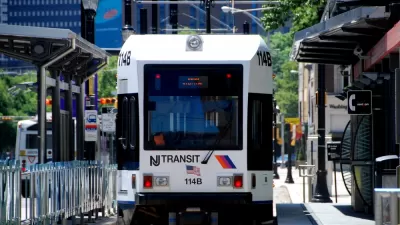The National Transportation Safety Board has determined that the minute before the Sept. 29 crash, the engineer suddenly accelerated, hurling the train into the wall of Hoboken Terminal, killing one person. They will work to find out why.
"In the minute before the crash, the train had been moving toward the platform at just eight miles per hour, the National Transportation Safety Board said," reports Emma G. Fitzsimmons, transit correspondent for The New York Times. The event recorder shows that the engineer then accelerated "to about 21 miles per hour...The speed limit for trains entering the busy station is 10 m.p.h."
Investigators have interviewed the train’s engineer, Thomas Gallagher, 48, who told them he did not remember the accident and woke up on the floor of the cab after the train had stopped.
While train safety experts urged for "automatic braking system" in the form of positive train control, Fitzsimmons writes, "Investigators said they did not know whether the technology would have prevented the crash in Hoboken."
One safeguard New Jersey Transit implemented on Oct. 5 for Hoboken and Atlantic City train terminals is to require "a second crew member to join the train engineer in the operating cab," adds Fitzsimmons. "The measure was aimed at providing a second set of eyes and ears during the final segment of trips into those stations."
On Oct. 1, Fitzsimmons reported that the Federal Railroad Administration "began an audit in June of New Jersey Transit...after noticing an increase in safety violations and a leadership vacuum at the top of the agency...After completing the audit, the federal agency issued a series of violations to the railroad, the official said."
A prescient Planetizen post appeared two days before the fatal crash noting that the NJ Transit’s board of directors had not held a public meeting in 109 days.
"Without public meetings, [legislators, transit riders and advocates] say, it’s impossible to know whether the political fight over state transportation funding is hurting NJ Transit’s ability to operate trains and buses safely."
Good news for NJ Transit commuters: The transit agency will "reopen a portion of Hoboken Terminal to commuter rail service for the start of service on Monday, October 10, 2016," according to a service alert.
FULL STORY: Train Was Traveling at Twice the Speed Limit Just Before Hoboken Crash

Planetizen Federal Action Tracker
A weekly monitor of how Trump’s orders and actions are impacting planners and planning in America.

Chicago’s Ghost Rails
Just beneath the surface of the modern city lie the remnants of its expansive early 20th-century streetcar system.

San Antonio and Austin are Fusing Into one Massive Megaregion
The region spanning the two central Texas cities is growing fast, posing challenges for local infrastructure and water supplies.

Since Zion's Shuttles Went Electric “The Smog is Gone”
Visitors to Zion National Park can enjoy the canyon via the nation’s first fully electric park shuttle system.

Trump Distributing DOT Safety Funds at 1/10 Rate of Biden
Funds for Safe Streets and other transportation safety and equity programs are being held up by administrative reviews and conflicts with the Trump administration’s priorities.

German Cities Subsidize Taxis for Women Amid Wave of Violence
Free or low-cost taxi rides can help women navigate cities more safely, but critics say the programs don't address the root causes of violence against women.
Urban Design for Planners 1: Software Tools
This six-course series explores essential urban design concepts using open source software and equips planners with the tools they need to participate fully in the urban design process.
Planning for Universal Design
Learn the tools for implementing Universal Design in planning regulations.
planning NEXT
Appalachian Highlands Housing Partners
Mpact (founded as Rail~Volution)
City of Camden Redevelopment Agency
City of Astoria
City of Portland
City of Laramie



























